Posted on 10-02-2025, by Anshu Mehta

Affordable housing is an ongoing challenge in India, with various government and private sector initiatives aimed at providing homes to low- and middle-income groups. The Indian government has rolled out several schemes and programs to promote affordable housing, such as:
1. Pradhan Mantri Awas Yojana (PMAY)
The PMAY is one of the largest initiatives, aimed at providing affordable housing to all by 2022 (extended for the completion of projects). The scheme is divided into two parts:
PMAY - Urban (PMAY-U): Focuses on providing housing in urban areas, with an emphasis on slum redevelopment, affordable housing, and credit-linked subsidies.
PMAY - Gramin (PMAY-G): Targets rural areas, providing financial assistance for building houses for the rural poor.
Key Features:
Financial assistance to economically weaker sections (EWS), lower-income groups (LIG), and middle-income groups (MIG).
Subsidy on home loans for eligible beneficiaries.
Target to build over 2 crore homes by 2022 (extended).
2. RERA (Real Estate (Regulation and Development) Act)
The RERA aims to promote transparency and accountability in the real estate sector, ensuring that developers adhere to approved plans and timelines. The act also protects homebuyers from fraudulent practices. This helps make affordable housing options safer and more trustworthy.
3. Housing for All by 2022
This is a broader goal set by the Indian government under which multiple schemes and partnerships are involved to make affordable housing a reality. It combines several initiatives, including PMAY, increased focus on the infrastructure development of tier-2 and tier-3 cities, and incentives for affordable housing projects.
4. Affordable Rental Housing Complexes (ARHC)
The ARHC scheme is designed to provide affordable rental housing options for migrant workers, urban poor, and low-income groups in urban areas. It encourages the private sector to build and manage rental housing complexes.
5. Credit-Linked Subsidy Scheme (CLSS)
Under PMAY, this scheme provides an interest subsidy on home loans for people from economically weaker sections. The scheme covers first-time homebuyers and offers significant reductions in the rate of interest for eligible beneficiaries.
6. State-Level Initiatives
Different Indian states have their own affordable housing schemes, often with additional incentives. For example:
Maharashtra's Mumbai Housing Policy: Focuses on affordable housing for low- and middle-income groups in Mumbai.
Tamil Nadu’s Affordable Housing Projects: Government projects in Chennai and other parts focus on the needs of the low-income population.
Uttar Pradesh Housing and Development Board: Works on providing affordable homes under the government schemes.
7. Private Sector & Public-Private Partnerships
Many private developers are focusing on affordable housing through collaborations with the government or via special financial schemes. Companies like Lodha, Godrej Properties, Tata Housing, and Mahindra Lifespace have entered the affordable housing segment, aiming to make homes more accessible to low- and middle-income buyers.
8. Smart Cities Mission
Although the primary goal of the Smart Cities Mission is urban development and infrastructure improvement, affordable housing is also a component of these smart cities. The government provides funds to develop high-quality, affordable housing with modern amenities in these areas.
Challenges and the Way Forward:
Despite these initiatives, challenges like land availability, high construction costs, and financing remain barriers to achieving truly affordable housing. However, with continued government support, partnerships with private developers, and improved funding options, affordable housing in India is gradually becoming more accessible to those in need.